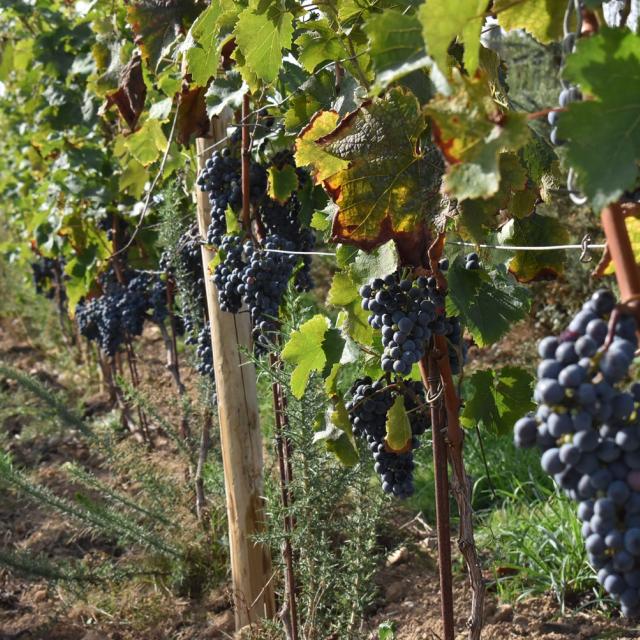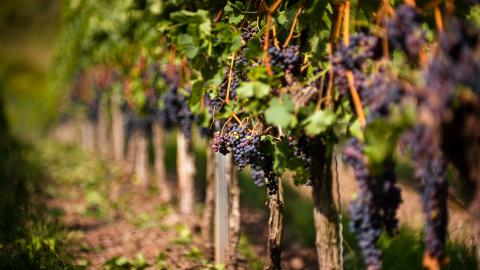The grape vine is considered to be a crop that is drought-resistant because of its rooting system, its water storage capacity and its ability to adapt physiologically, by partially closing its stomata. However, these qualities do not mean that the vine‘s atmospheric demand for water cannot be offset (by irrigation) to allow it to regenerate and permit the gas exchanges required for its survival and growth. The greater the surface area of the vine’s leaves the greater will be its water requirements.

To decide on the timing and amount of irrigation to be applied, then it is important to know the background and significance of the irrigation requirements of the vineyard. The atmosphere exercises a demand for water derived from the solar radiation, via the plant’s stomata, which guarantees the gas exchange of water and CO2, thus allowing for photosynthesis to take place. This is the basic requirement for the vine’s growth and productivity, sugar formation and the metabolism of the derived substances, such as organic acids, polyphenols, aromas, etc.
The solar energy generates a vapour-pressure deficit at the surface of the leaves and, consequently, evapotranspiration takes place. The potential or reference evapotranspiration (ETo), calculated in mm (litres/m2), is the maximum possible quantity of water absorbed by the atmosphere if the whole soil surface is covered in plants, turf grass for example, and the plant has unlimited water availability. In the case of the vineyards, the evaporative demand will generally be less than ETo, because the crop does not cover the whole of the soil surface. ETo depends on four meteorological parameters: temperature, moisture, solar radiation and wind speed.
The vine should transpire a certain quantity of water for each unit of dry matter (DM) that it produces, whether this relates to leaves, stems or bunches of grapes. It is estimated that to produce 1 kg of dry matter, the vine must transpire around 500 litres of water. Thus, to produce 8,000 kg of grapes per hectare, the plant must transpire the water necessary to produce 4,000 kg of DM, since the grape contains 20% dry matter by weight and this represents 40% of the total weight of the vine. In this situation, 50 L x 4,000 kg of DM/ha = 200,000 litres/ha, 200 mm (2,000 m3/ha). If this amount cannot be extracted from the soil throughout the whole vegetative period, the vineyard will have less growth and production.
The water that the plant releases to the atmosphere is extracted from the soil by the roots, but the soil matric potential, i.e. its resistance to releasing the water to a greater or lesser degree depending on its structure and texture, in such a way that the plant will have a degree of difficulty in extracting the water from the soil, which, conversely, depends on the quantity of water available in each type of soil. If there is little water available in the soil, the evapotranspiration and vine growth will, logically, be reduced.
A plant water deficit is produced in the vine when the water demand of the evapotranspiration into the atmosphere is greater than the amount of water that the plant can extract from the soil. The level of deficit depends on the level of evapotranspiration, leaf area and soil moisture content.
Calculating the irrigation requirement on the basis of evapotranspiration
Evapotranspiration is a reality that has to be overcome by the vineyard, which is why the most elementary basis for calculating the irrigation of the vine is measuring the potential evapotranspiration (Eto), in order to estimate the evapotranspiration of the crop (Etc), by applying a crop coefficient, Kc, which basically depends of the crop‘s stage of growth and leaf development.
Thus, the need to manage the vine will be a lot less in May, when the ETo is lower and leaf development has not yet reached its maximum, than in July, when the ETo is higher and vegetative growth is at its maximum. The ETc is obtained by multiplying the ETo by the crop coefficient (Kc), which can vary between 0 and 1 in the most extreme situations or approaches.
When calculating the amount of irrigation required for a given period, the water balance has to be considered, by deducting the quantities of rainfall (mm) from the estimated ETc. On the other hand, the water readily available in the soil can also be incorporated, especially in the spring. The readily available water in the soil is the difference between the soil water content at field capacity and the plant’s wilting point, estimated for example in the first metre of soil, measured from the surface. It is generally understood that, normally, 2/3 of the available soil water content can be considered as readily available to the plant. Calculating the irrigation requirement (mm) for a plant for a period of one week, for example, must be based on the following formula:
Irrigation = ETc - R (rainfall) - RAW (readily available water)
The irrigation strategy is heavily reliant on the crop coefficient, Kc, applied. Within the context of a production-oriented approach, this coefficient could vary, from May to September, between 0.50 and 0.70, which could represent - taking as a benchmark a readily available soil water reserve of 70 mm - more than 300 mm. If the irrigation strategy is more oriented towards the quality of the grape, the coefficient Kc could vary between 0.25 and 0.40, which would more or less represent a little more than 100 mm of water, an amount which is well below that of the first strategy.
By way of an example, in the Ribera del Duero, oriented towards grape-quality, generally-speaking, it is not necessary to irrigate between bud break and flowering because of the amount of readily available water in the soil and the coefficient Kc can be set at between 0.2 and 0.4, which represents 90 and 180 mm of irrigation water applied during the summer, depending on the type of soil and production required.
It is important to know the precipitation rate (mm) of the irrigation system, or the flow rate per unit of soil surface (L/m2), because the ETo or estimated requirements must be expressed in mm (L/m2). Thus, for a drip irrigation setting of 3.00 x 0.75 m, each emitter covers 2.25 m2 of soil. If the flow rate of the emitters should be 2 L/h, then the precipitation rate will be 0.93 L/m2 (mm/h). To apply an irrigation amount of 12 mm per week (according to the example for calculating the weekly ETc), it will be necessary to irrigate for 13 hours (12 mm / 0.93 mm/h).
Irrigation management based on the soil moisture content.
The soil represents a reservoir that retains the water according to its texture and structure. A sandy soil has a lower water holding capacity than a clayey soil, although for the same volume of water stored, a sandy soil holds it under less tension (suction) and releases it more readily than a clayey soil.
The aim of irrigation is to place the water at the disposal of the roots within the soil horizons where they are located. Consequently, the amount applied and frequency of the irrigation should be adapted to the depth and texture of these horizons in the soil profile. It is necessary to know the capacity of the soil water reserve of the soil horizons, on the basis of their field capacity and their wilting point. Excesses and shortfalls in the irrigation amounts applied will thus be avoided.
A moderate water deficit in the vine can improve the quality of the grape because the stress is more likely to affect vegetative growth than the development of the grape berries.
This observation has led to the development of controlled deficit irrigation (CDI) strategies, which aim to restrict the water in certain stages of the cycle, mainly between the fruit set and the beginning of the ripening of the grape (veraison), so as to regulate the size of the berries, benefitting the skin-pulp relationship and, consequently, the concentration of metabolites associated with grape quality.
To put in place a controlled deficit system of irrigation, the tools will have to be used that enable the soil water content or tension to be calculated , such as moisture sensors or tensiometers to facilitate the management of the irrigation application. It is particularly important for the irrigation system to be well-designed with sufficient, minimally uniform and well distributed sectors, because, otherwise, nothing is gained by using good indicators and irrigation estimates if the irrigation system does not distinguish between the different types of soil, according to texture, slope or soil depth.
Irrigation management based on using the plant as an indicator.
The plant is an integral indicator of the vine’s plant water conditions, combining the effects of the soil and the atmosphere, even though it can be difficult to interpret its water status.
The most elementary indicator, taken at the beginning of ripening, is achieved via a direct observation of the growing stems, which should be made very frequently, in a manner that, if the most distant tendrils are above the shoot apex or even close to it, then it will not be necessary to irrigate, but if the tendrils are not visible, then there will be signs of plant water stress, which will become chronic if the shoot apex is no longer green or disappears.
Various tools can be used to estimate the plant water status objectively and provide an early prediction of the irrigation requirements based on a visual observation.
The device most commonly used for this assessment is the pressure chamber, which measures the water potential of the leaves or the inverse force retaining the water in the plant.
The level of water stress, corresponding to the water potential, must be adapted to the type of wine required because the increasing water stress gradient results in a wine production that ranges from herbaceous to acidic, when there is no stress, to fruity and tannic, when there is moderate stress to very alcoholic (dry) and astringent, when there is excessive stress.
In brief, the irrigation must meet objective criteria in order to adapt the water status to the conditions of the vineyard so as to generate an optimum response for each plot, as the irrigation management cannot be the same for different vineyards, and this on the assumption that the irrigation strategy to be applied takes into consideration the type of grape and wine to be produced.

